Ski-Doo Pushes Innovation to New Levels…
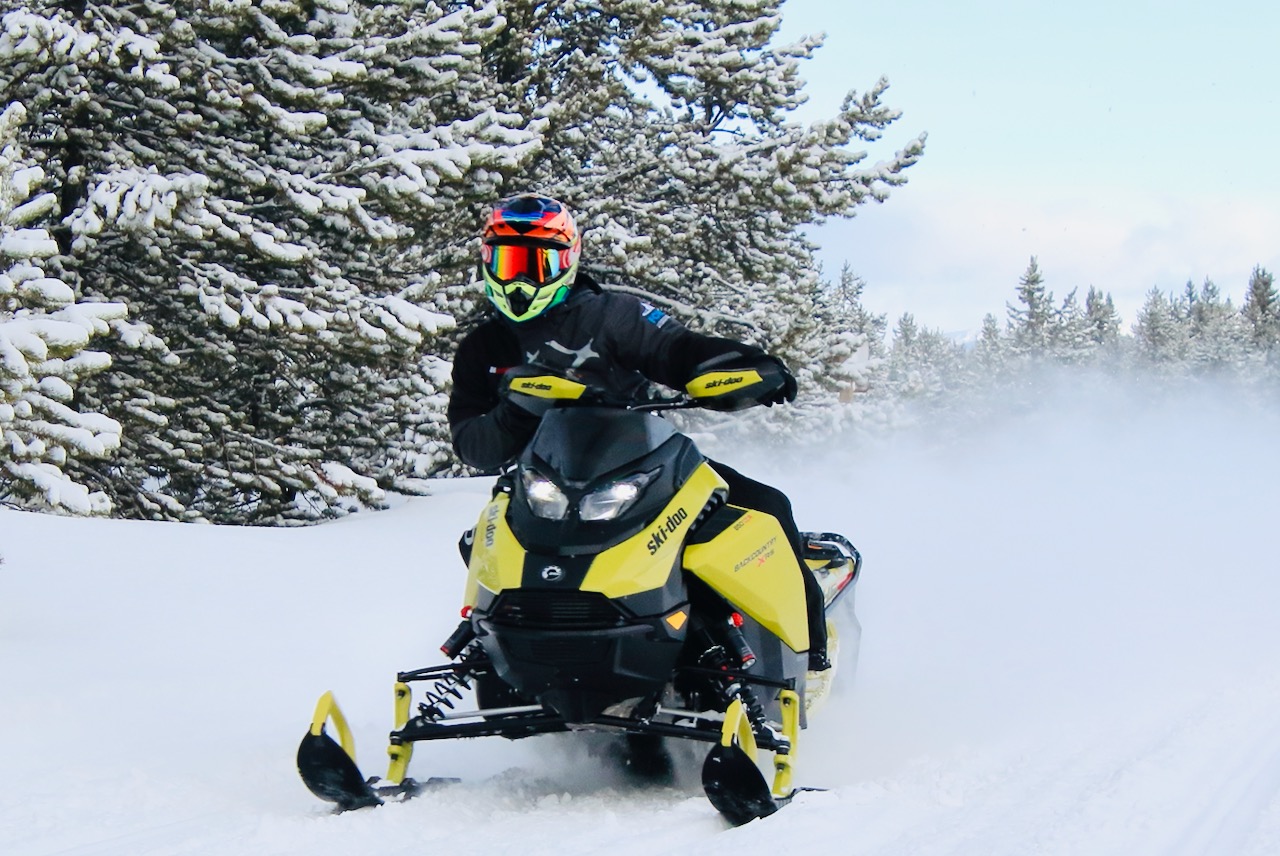
Photo courtesy of Motoneige Quebec/sledmagazine.com
Related: What’s new For – Yamaha / Lynx / Arctic Cat / Polaris
My Introduction
2025 Ski-Doo snowmobiles is the fifth and final post about “What’s New” from the Original Equipment Manufacturers (OEMs). It won’t be the last time we benefit from the tech know-how and expertise of powersports journalist Michel (Micky) Garneau. But it will likely be a long time before we have ”What’s New” reports on five OEMs again. So, if you missed any of Micky’s What’s New for 2025 posts, check them out – exclusively on my website ( see Related above) plus, of course, this one on Ski-Doo. Thanks for your insight, Micky!
2025 Ski-Doo Snowmobiles: What’s New
Built with an unmatched attention to detail, sleds made by BRP generally lead their respective categories in refinement. However, Ski-Doo sleds have had their weaknesses. For example, lack of handling precision is one persistent shortcoming on certain models, particularly in segments where the target clientele considers it a key factor. That said, Ski-Doo has not reached sales leadership by turning a deaf ear or sparing innovation efforts.
In fact, 2025 Ski-Doo snowmobiles deliver with a new front suspension and a new ski on certain models for 2025. These two developments are precisely designed to satisfy sporty driving enthusiasts. Meanwhile, fans of crossover models benefit from the arrival of the powerful 850 E-TEC Turbo R engine. Plus, there’s a new version of the Backcountry X-RS, designed for those whose mixed riding tends more towards trails. Furthermore, techies will appreciate on-going evolution of the 10.25″ interactive display. All told, it’s obvious the Valcourt-based manufacturer has no intention of letting off the throttle.
2025 Ski-Doo Snowmobiles Overview
Expedition Electric
Not surprisingly, Ski-Doo expands its range of electric models for the 2025 model year. The new Expedition Electric is powered by the same Rotax E-Power powertrain as its Grand Touring Electric sibling. It also uses the REV G5 chassis. Other similarities include 26 cm (10.25 in) interactive dashboard, LED headlights, 12 cm (4.7 in) handlebar riser block, J-hooks, hand and thumb warmers, medium windscreen and reverse. But note that, unlike its touring counterpart, the Expedition Electric has a longer tunnel. It’s specific to the 348 cm (137 in) track models, ready for two standard sets of LinQ brackets.
The Expedition Electric also features a two-up seat with a passenger strap, rather than handles and a backrest. The front suspension is the RAS X, while the rear is the SC-5M, a non-coupled design. As for the shock absorbers, Motion Control units are used front and center. Meanwhile, the rear shock absorber is a KYB 36 high-pressure gas version.
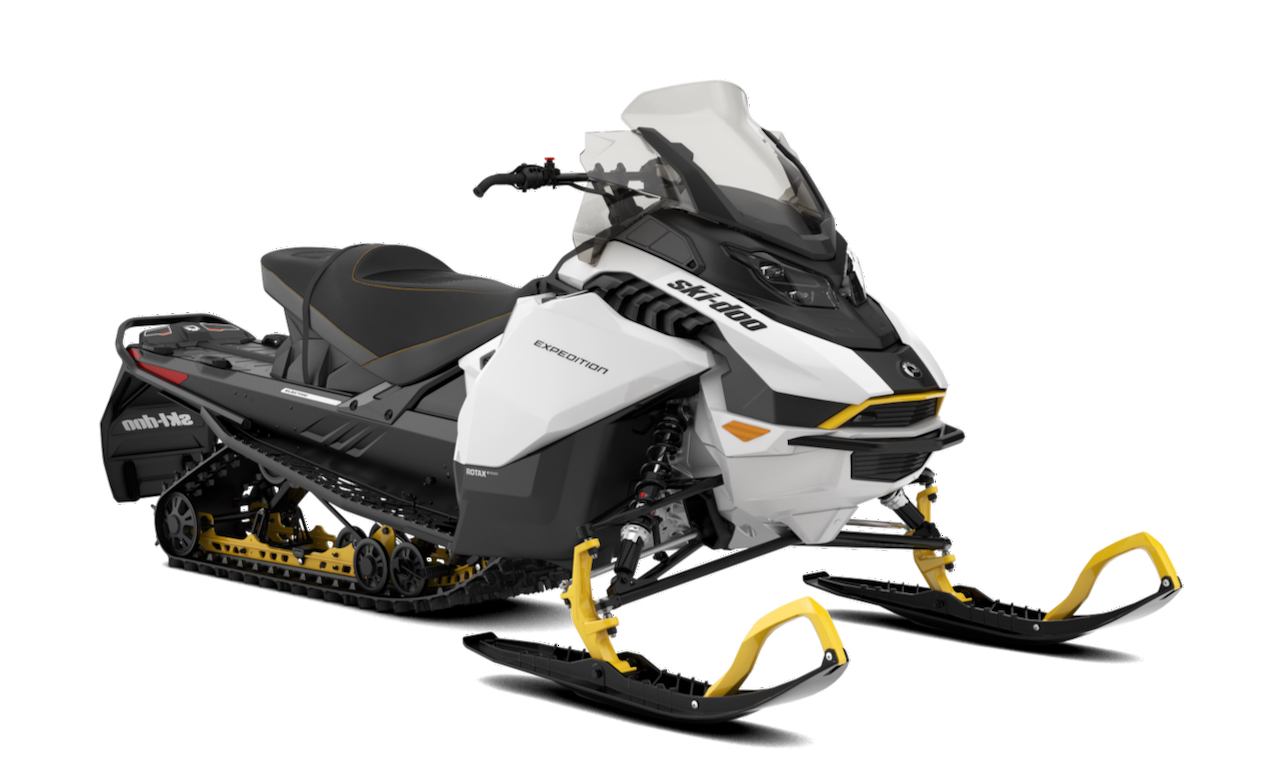
Electric Expedition, Photo courtesy BRP
The Expedition Electric occupies the touring-utility niche. This means its mandate includes the ability to travel in all snow conditions. Achieving this mission required changes to the track and skis. Thus, the Expedition Electric comes with Pilot DS 2 skis. It also has a 38.1 x 348 x 4 cm (15 x 137 x 1.6 in) Cobra track to increase its flotation and grip in loose snow. It’s worth noting that the track is a single-ply design. This cuts weight and reduces rolling resistance. Despite this, the increased drag created by the new parts reduces its range to a maximum of 30 km. This eliminates any possibility of long rides. But it could still meet the needs of those looking for a clean and quiet snowmobile, such as maple syrup producers or farmers.
“Turbo” Backcountry X-RS
The Backcountry X-RS sub-family now also includes a turbocharged version. This is an expected move, particularly after the arrival of the powerful 850 E-TEC Turbo R in an MXZ trail model last year. The Backcountry version of the turbocharged two-stroke engine features an intake cooling system. It injects a water- and methanol-based coolant into the intake stream. This reduces risk of detonation and enables maintaining engine power for longer periods. The recoil starter comes standard with the SHOT starting system. The Backcountry X-RS 850 E-TEC Turbo R is available only as a 370.8 cm (146″) track version.
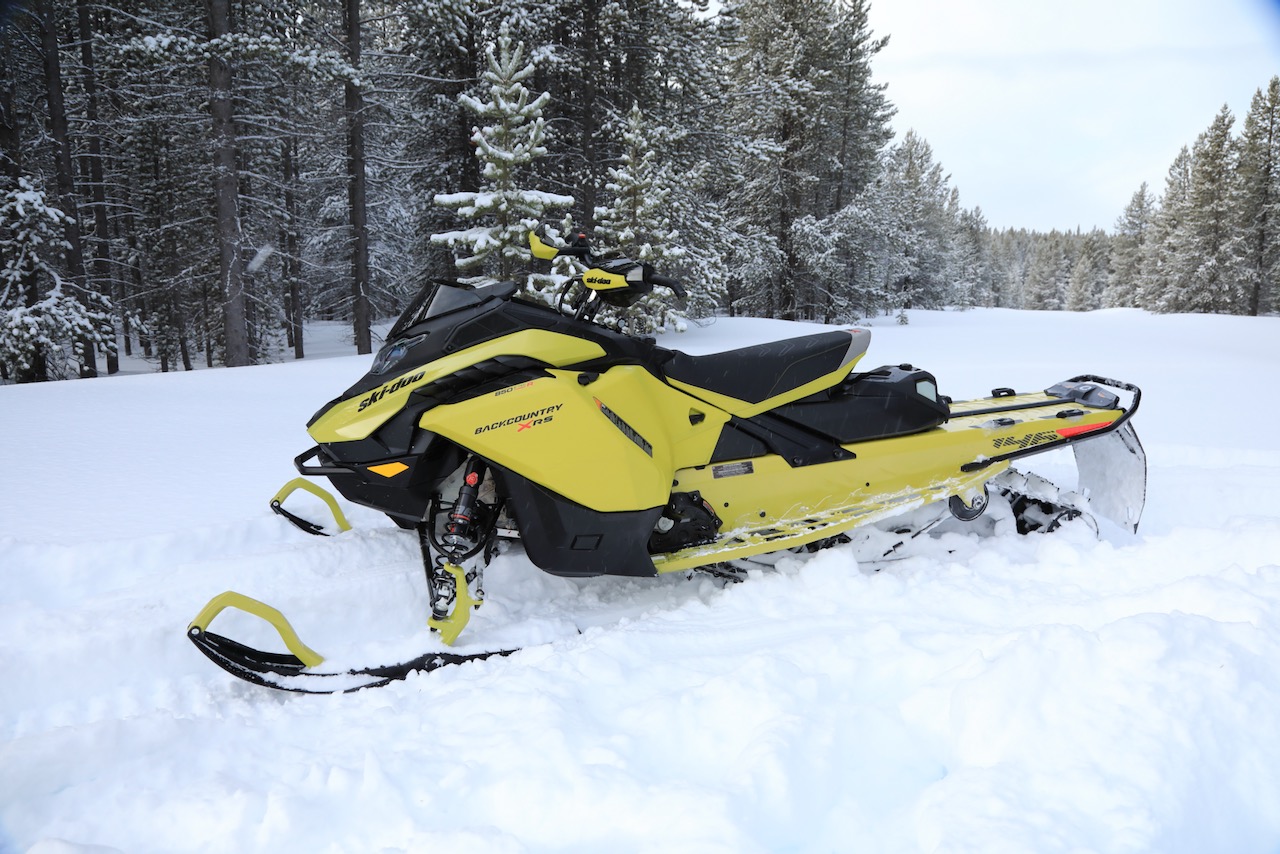
Backcountry X-RS 850 E-TEC Turbo R. Photo courtesy of Motoneige Québec/sledmagazine.com
RAS RX Front Suspension
Barely four years after the introduction of the RAS X front suspension, 2025 Ski-Doo snowmobiles present the all-new RAS RX. It’s closely inspired by the suspension of the 600 RS racer, winner of numerous snocross races and championships. The RAS RX gets a complete redesign, with the aim of improving the snowmobile’s stability, particularly when cornering.
Cornering
The suspension overhaul begins with new spindles, They are longer/taller than those found on the RAS X (or 3). The position of the upper ball joint is now 26 mm higher. The lower ball joint is 15 mm lower (relative to the upper one) than on the RAS X. This increases the distance between the lower A-arm mount anchor and the ski attachment point by 11 mm. In concrete terms, upgrading the spindles keeps the A-arms flatter and increases the clearance between the front of the snowmobile and the trail.
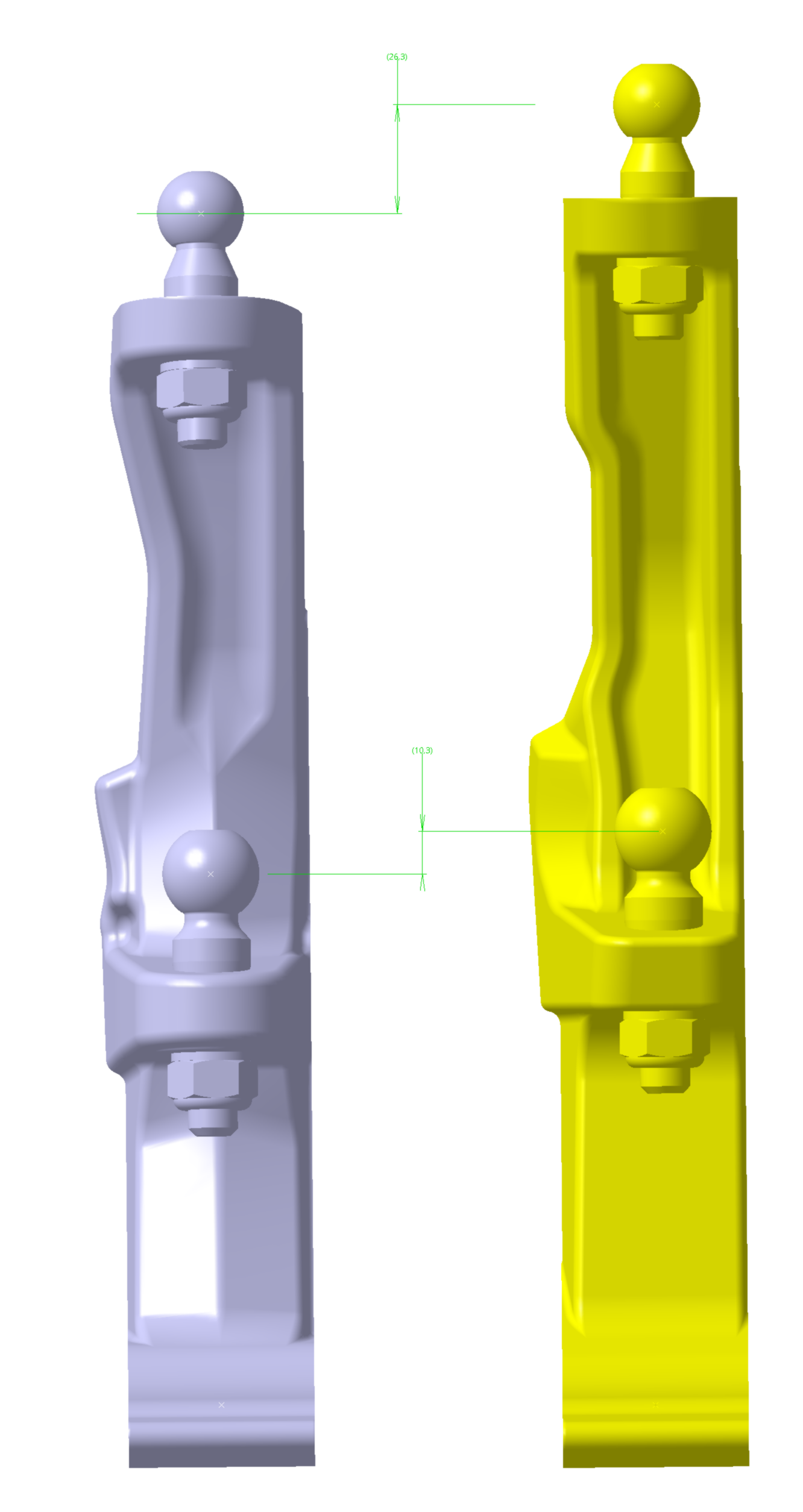
RAS X spindle (left) and the RAS RX spindle (right). Visual courtesy BRP
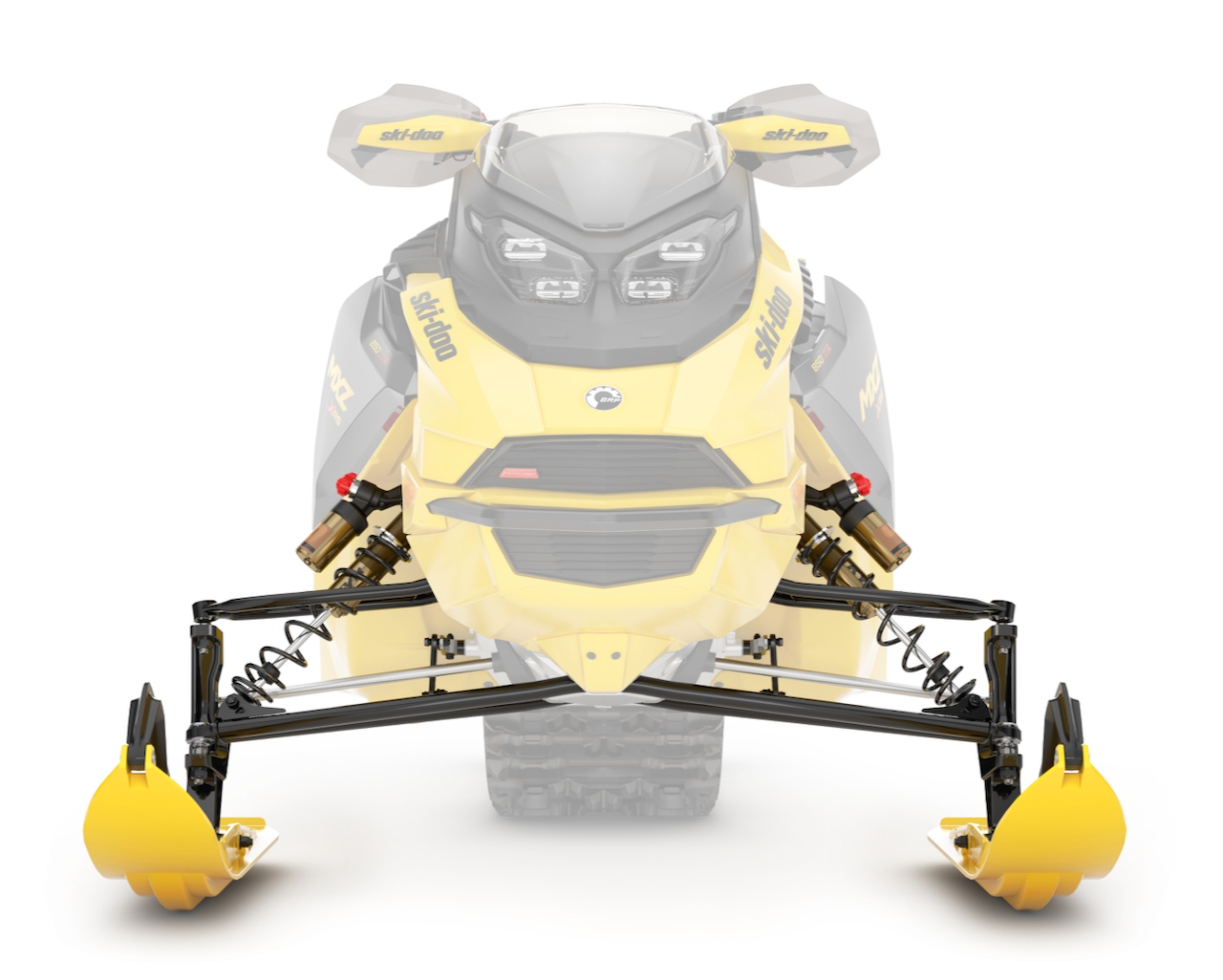
Upgraded spindles keep the A-arms flatter, while increasing clearance under the front of the snowmobile. Visual courtesy BRP
Why make these changes? To relocate the snowmobile’s roll center (see Micky’s “roll center 101” explanation below in My Last Word section). By revising these key elements of the front-end geometry, the engineers raised the roll center by 2.5 cm (0.98 in), bringing it closer to the snowmobile’s center of gravity. In doing so, they reduced chassis roll by 20%. This translates into greater stability when cornering, as the inner ski of the snowmobile is less likely to lift.
However, Ski-Doo’s drive to improve cornering stability didn’t stop there. Their engineers have also repositioned the lower shock absorber mount on the A-arm. Giving the shock absorber a flatter angle increases resistance to lateral forces. In addition, the revised stabilizer bar mechanism makes it more effective at the start of its motion.
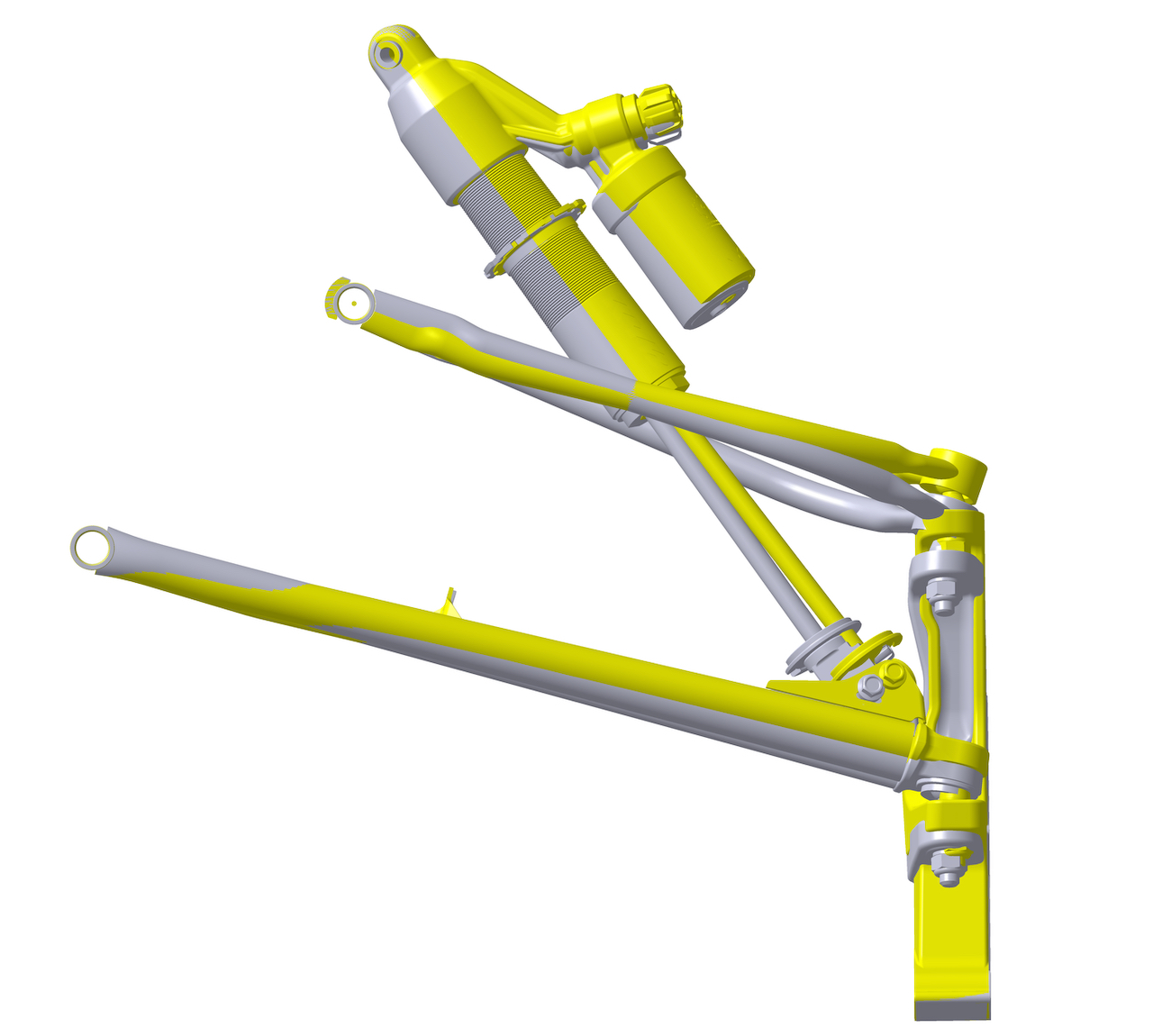
New shock absorber geometry (RAS RX front suspension in yellow, RAS X in grey) required recalibration of the shock & spring. Visual courtesy BRP
Straight Line Stability
Having taken care of the issue of cornering stability, Ski-Doo engineers turned their attention to straight-line stability. This is a particularly important feature when riding aggressively through bumps. The new spindles add 0.4 cm (0.16 in) of trail (the distance the ski attachment bolt is retracted behind the true pivot centre of the arm). This change takes it from 1 cm to 1.4 cm (0.4 in to 0.6 in), making it identical to the 600 RS, with increased “self-straightening” tendency of steering and reduced jolting.
To counter the increase in effort required at the handlebars with the addition of trail, the engineers extended the “steering arm” portion of the spindle (i.e. the distance between the centre of rotation and the attachment point of the steering tie rod). A side-effect of this change is that the riders must turn the handlebars more to produce the same relative degree of turning of the skis.
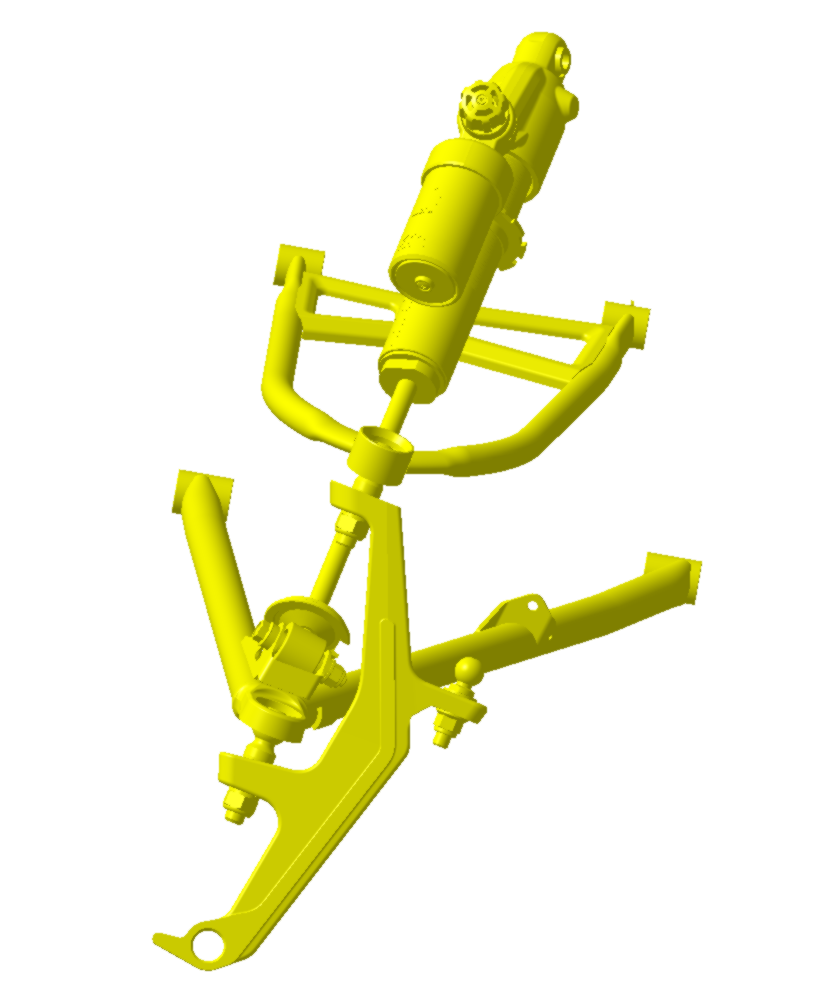
RAS RX front suspension. Visual courtesy BRP
Suspension Travel
The finishing touch on the RAS RX is a 1.4 cm (0.6 in) increase in suspension travel to 27.9 cm (11 in). This increase in movement necessitated the use of slightly curved A-arms close to their anchoring points on the chassis. This provides extra clearance to the chassis at full compression.
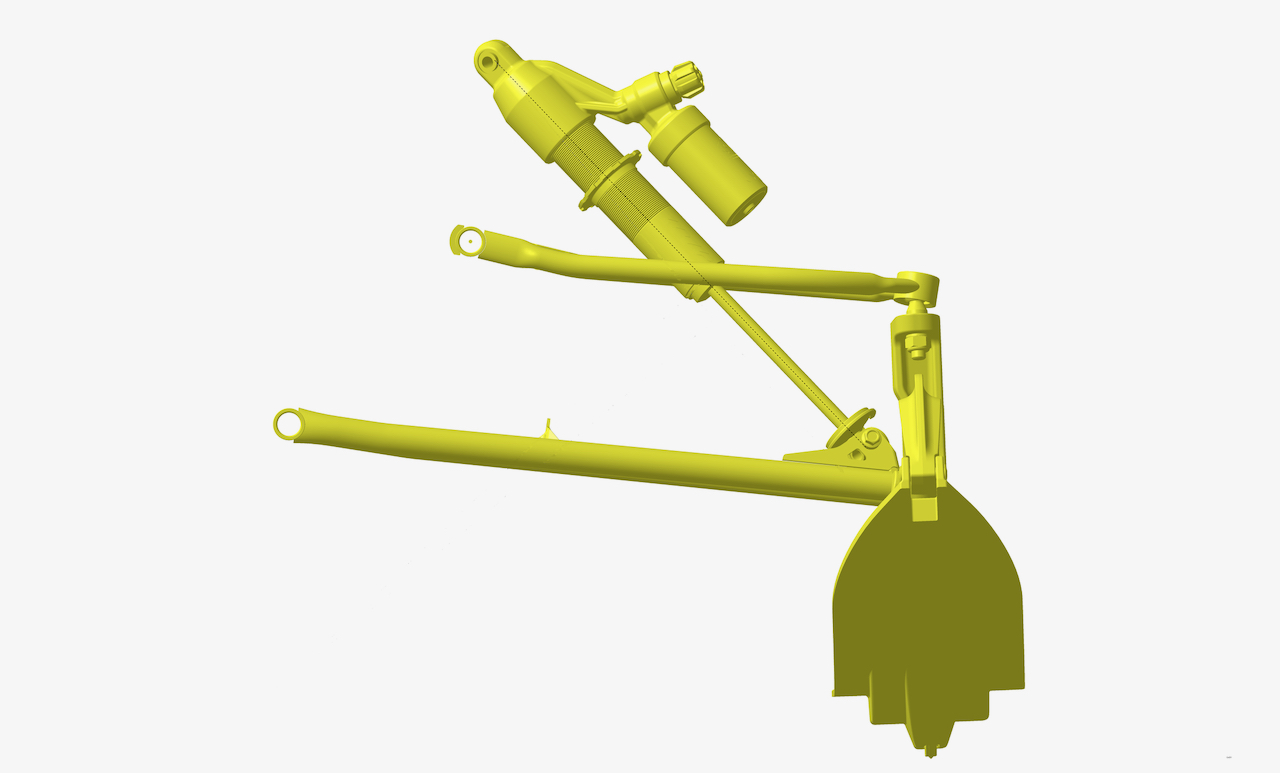
Slightly curved A-arm close to its anchoring point on the chassis. Visual courtesy BRP
Finally, while many things have been changed, two existing features have not. The mounting points of the A-arms on the chassis and the ski stance, which remains 109 cm (43 in). The new RAS RX suspension comes on all MXZ models (except the Sport and Neo versions), as well as on the new “S-42” edition of the Backcountry X-RS.
Pilot RX Ski
The Pilot RX ski compliments the new RAS RX front suspension on certain top-of-the-range models: the MXZ X-RS, the MXZ X and the new Backcountry X-RS “S-42” version. This new member of the Pilot ski family delivers better grip and greater predictability in powder and loose snow conditions. The designers no doubt got inspired by the Blade XC+ ski from Ski-Doo’s sister company Lynx. Hence, the use of an aggressive two-step keel. The first step is 2.2 cm (0.9 in) high, while the second is 4.7 cm (1.9 in), or 1.3 cm (0.5 in) higher than that of the Pilot X ski it replaces.
One of the differences between the two skis is in the profile of the central keel. The Blade has a square cross-section, while the Pilot RX has slightly angled sides. I’m told that this feature of the RX facilitates the transition between different snow conditions, reducing the jolt intensity felt by the rider.
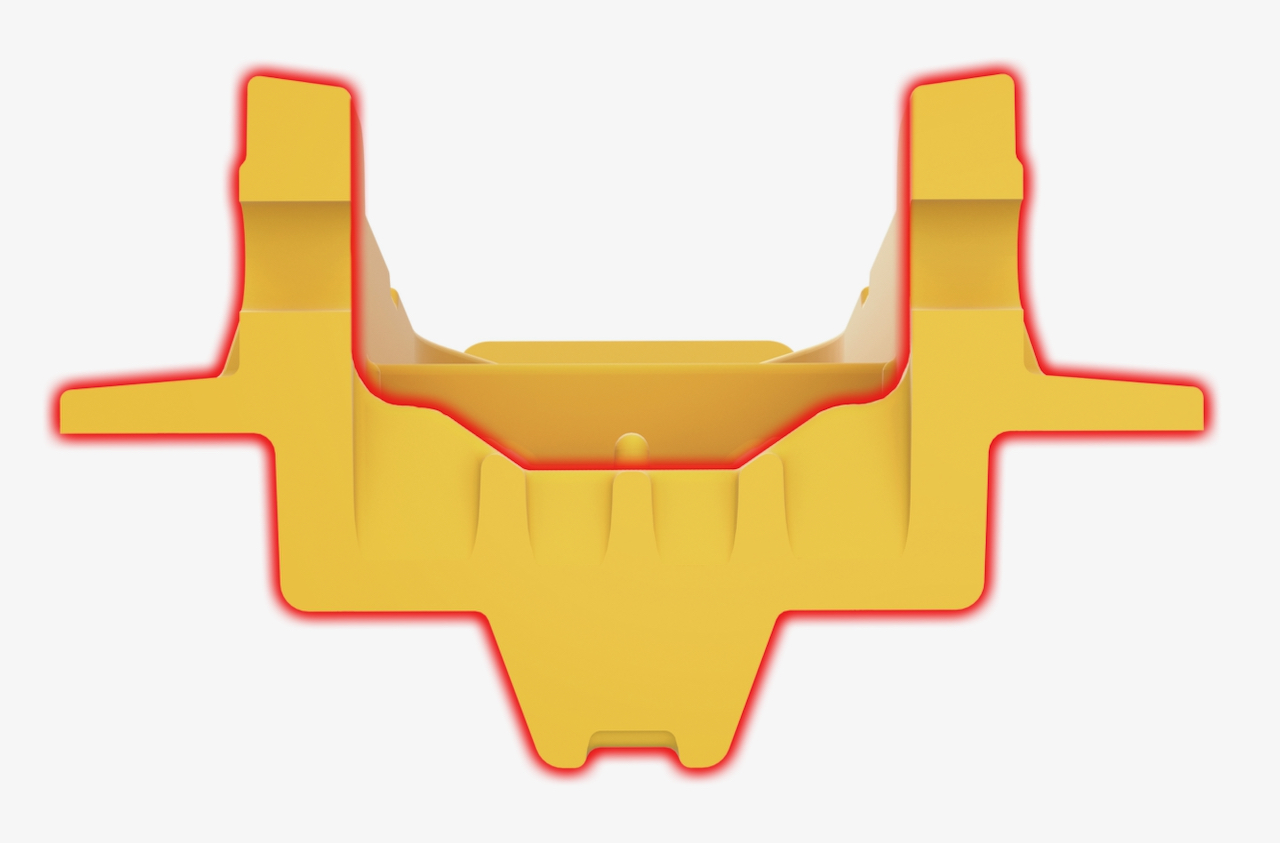
Pilot RX has slightly angled sides (red outline) compared to Blade’s square cross-section. Visual courtesy BRP
And that’s not all. The keel has a total length of 64.5 cm (25.4 in), an increase of 9 cm (3.5 in) compared to the Pilot X keel. Together, the lateral surface of the two keels totals 250 cm2 (38.8 in2), a gain of 60% compared with its predecessor! Its greater width – up from 14 to 16 cm (5.5 to 6.3 in) – will undoubtedly provide better effectiveness in loose snow.
2025 Ski-Doo Snowmobiles: Chassis
Let us now turn to matters of a more evolutionary nature.
Interactive Display
BRP’s 10.25″ (26 cm) high-definition colour touchscreen launched in 2023 as part of the introduction of the REV G5 chassis. It continues to evolve with the addition of new features and functionality. First, the 2025 version comes with built-in GPS, so you can navigate without a phone connection. You can see your position at all times (including in compass format, with north up) on the built-in topographical maps and consult organized snowmobile trails where such data is available. You can also save your route using breadcrumbs, enabling you to revisit it in the future. Note that these routes remain accessible until the memory is emptied. The search for points of interest is also improved.
Finally, trail enthusiasts wanting access to more features can plug in their phone and use the free BRP GO! application. Both Ski-Doo and Lynx use this display, the latter in models built on the Radien2 platform. Also new for 2025, buyers of MXZ X-RS and MXZ X models with the 600R E-TEC engine are now able to order the optional top-of-the-line display.

Interactive display map. Visual courtesy BRP
Seat
Many Ski-Doo models get new seats for 2025. Beginning with the Renegade line-up, the Sport model swaps its “compact trail” seat for the “narrow and compact” version. This change will make moving around easier for novice riders. At the other end of the Renegade family, the X and X-RS versions are equipped with a standard heated seat for 2025 (plus a practical heated visor socket as an added bonus).

Renegade X-RS. Photo courtesy Motoneige Québec/sledmagazine.com
Meanwhile, the Tundra models (LE and Sport versions) are also equipped with a “narrow and compact” trail seat for the 2025 model year. However, the decision to replace the “2-seater – short” seat and its accompanying strap used on past Tundra models unfortunately precludes carrying a passenger with the standard seat.
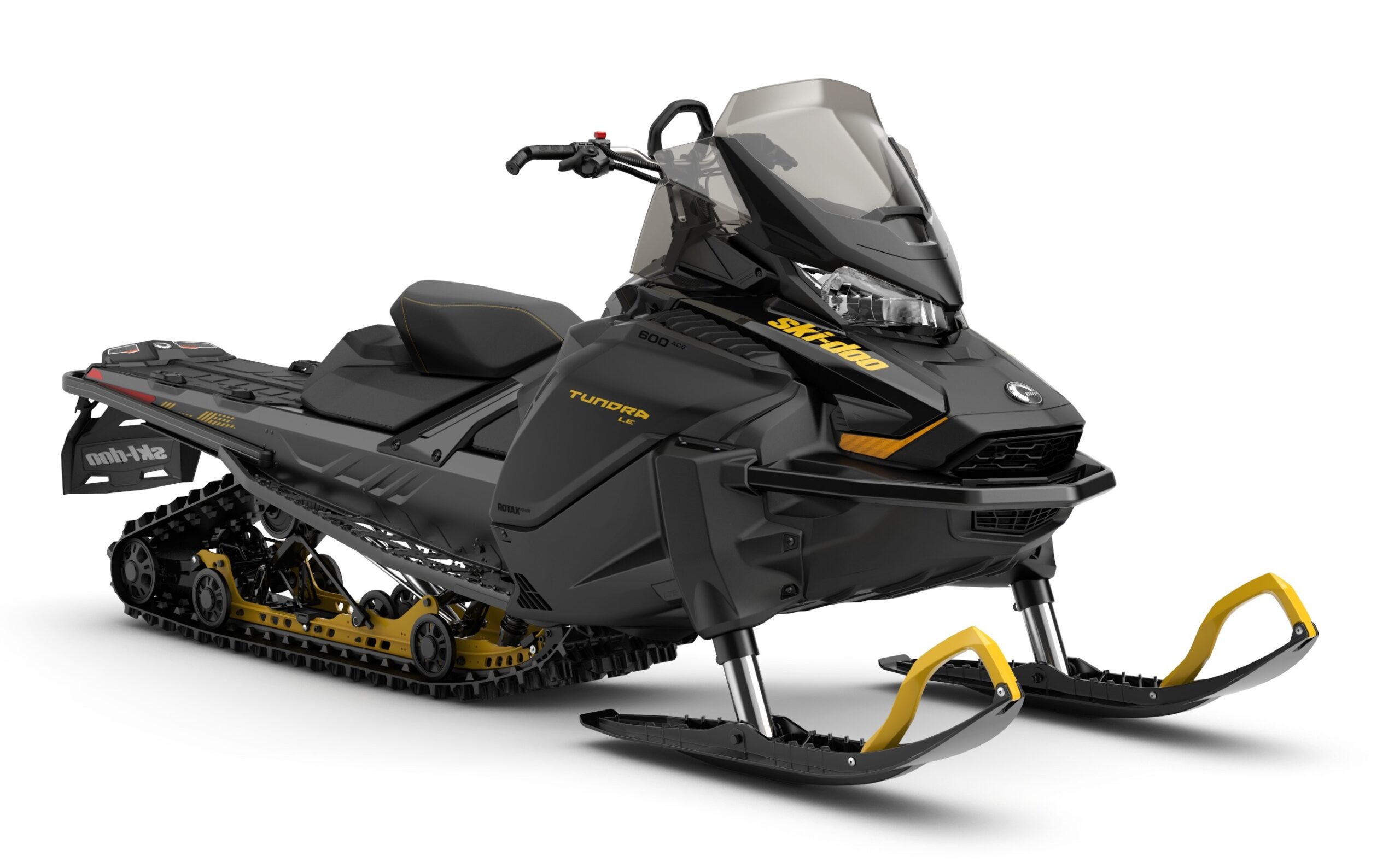
Narrow & compact Tundra seat. Photo courtesy BRP
Braking System
The vast majority of full-size 2025 Ski-Doo snowmobiles are equipped with a new aluminium master cylinder with integrated reservoir. It debuted last year on the Summit X with Expert package and the MXZ X-RS with Competition package. Still manufactured by Brembo and identical in terms of geometry (i.e. piston diameter and fulcrum length), it’s stronger than the plastic reservoir version it replaces. The Skandic and Tundra families, as well as the Neo and Neo + versions of the MXZ and Summit models do not get this upgrade.
The brake system introduced last year on the X-RS versions of the MXZ and Renegade models migrates over to the 2025 X versions. More specifically, it includes an oversized brake rotor (from 20 to 22 cm [7.9 to 8.7 in] in diameter) that is 10% thicker. It also provides a four-piston caliper (four 30 mm pistons instead of the two 40 mm pistons used in the past). The configuration of the new pistons gives them 12.5% more surface area. This increases the pressure exerted against the pads, which in turn now have 10% more surface area. These two upgrades increase mechanical and hydraulic leverage for greater power and better feedback.
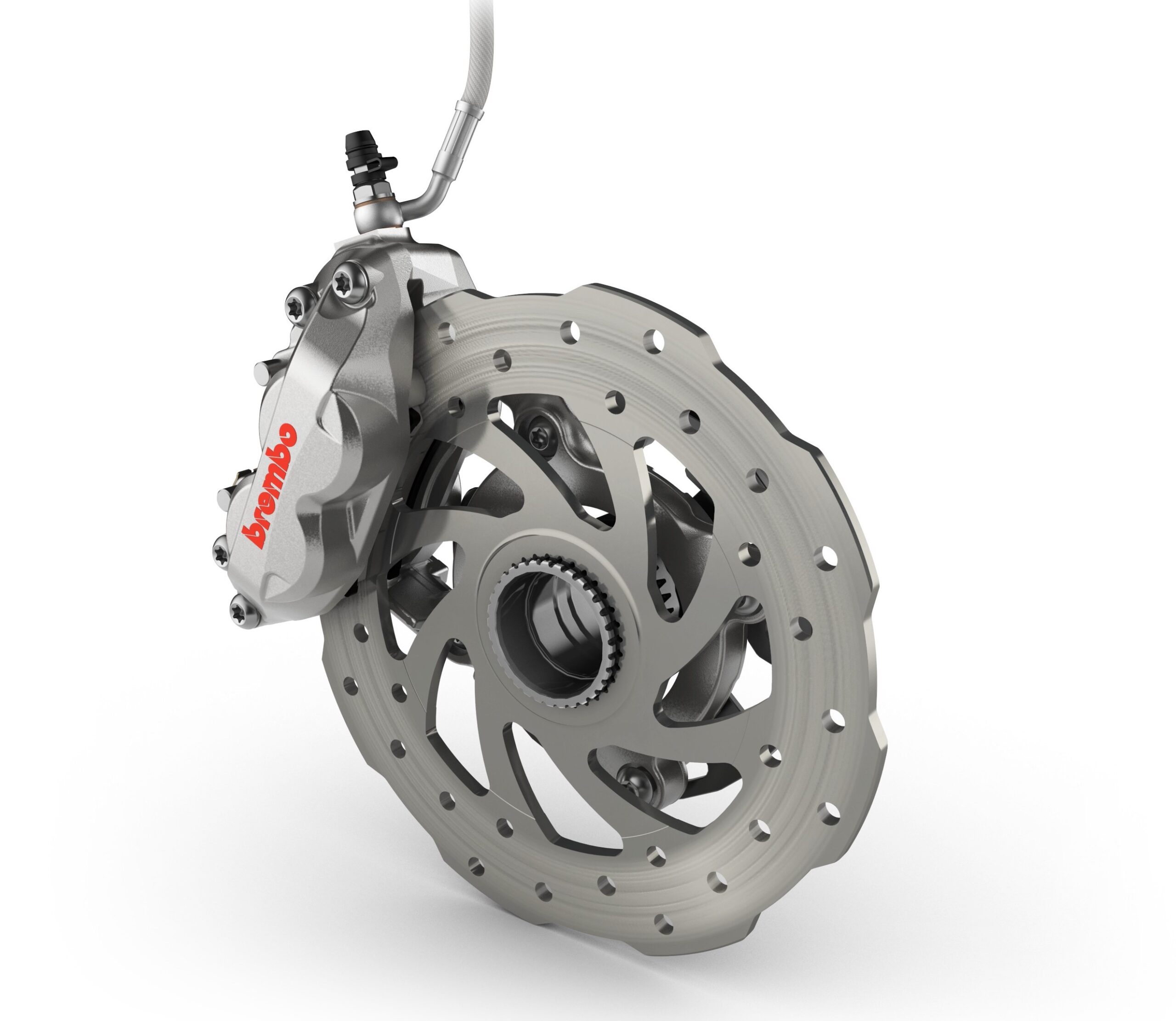
Upgraded Brembo brake system. Photo courtesy BRP
Independent Warmer Adjustments
The engineers at Ski-Doo have listened to their customers about the impossibility of adjusting the heat intensity of the hand and thumb warmers independently. For 2025, riders will once again be able to adjust the heat level of these two systems separately.
2025 Ski-Doo Snowmobiles: Suspension
Backcountry X-RS “pro-trail” Versions
The Backcountry family of models has long been the exclusive domain of true 50/50 crossovers. In part, this is thanks to the decision to equip them with a mid-width front suspension. This general alignment changes for 2025 with the addition of a new, more “trail-friendly” variant. Specifically, a new Backcountry X-RS now comes equipped with the new RAS RX front suspension (with its “full-width” ski stance) and the Pilot RX ski. Designated “S-42”, it features the same shock absorbers as its traditional siblings. KYB Pro 36 EA-3s at the front and KYB Pro 40 EA-3s at the rear, with three-way (Low-speed) adjustable compression.
Curiously, this model is only available in a track length of 370.8 cm (146 in). Two track options are on the menu: a Cobra or an Ice Cobra (with encased studs), both with 4 cm (1.6 in) lugs. However, the Backcountry X-RS “S-42” with 850 E-TEC Turbo R engine is available only with the Cobra track.
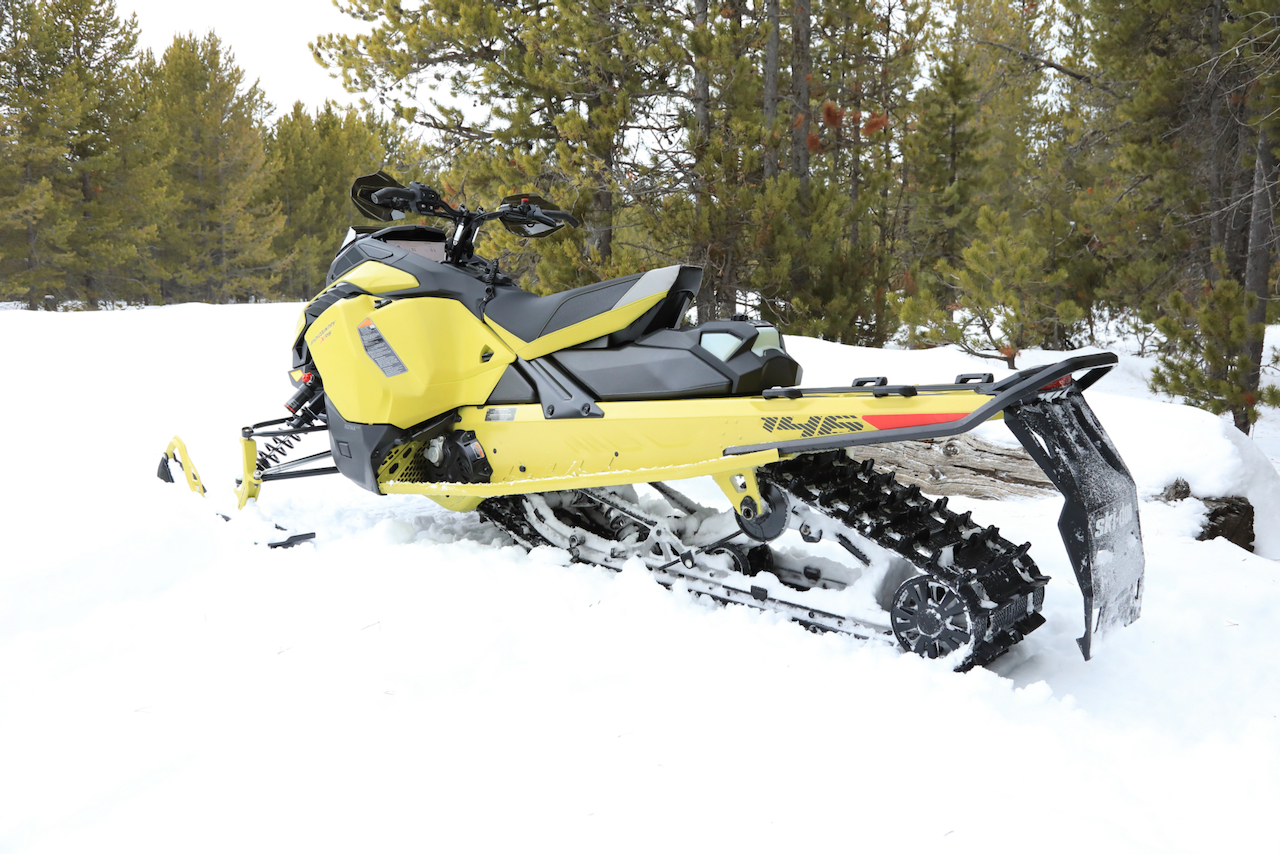
Backcountry X-RS with 142″ track. Photo courtesy Motoneige Québec/sledmagazine.com
Smart-Shox System Expands
The Smart-Shox semi-active suspension system comes on more 2025 models. Introduced in 2022, this system manages the damping characteristics of front shocks, as well as the rear-most damper in the rMotion X suspension. This is made possible based on key data collected by five sensors located at different points on the snowmobile. For 2025, the Smart-Shox system is available as an option on the MXZ X-RS 850 E-TEC Turbo R with Competition Package and on the MXZ X-RS 600R E-TEC.
Unlike the versions with “standard” shock absorbers, whose front travel increases to 27.9 cm (11 in) with the adoption of the new RAS RX suspension, the Smart-Shox versions remain at 26.5 cm (10.4 in), This is due to the space occupied by the adjusters, whose presence reduces the available travel.
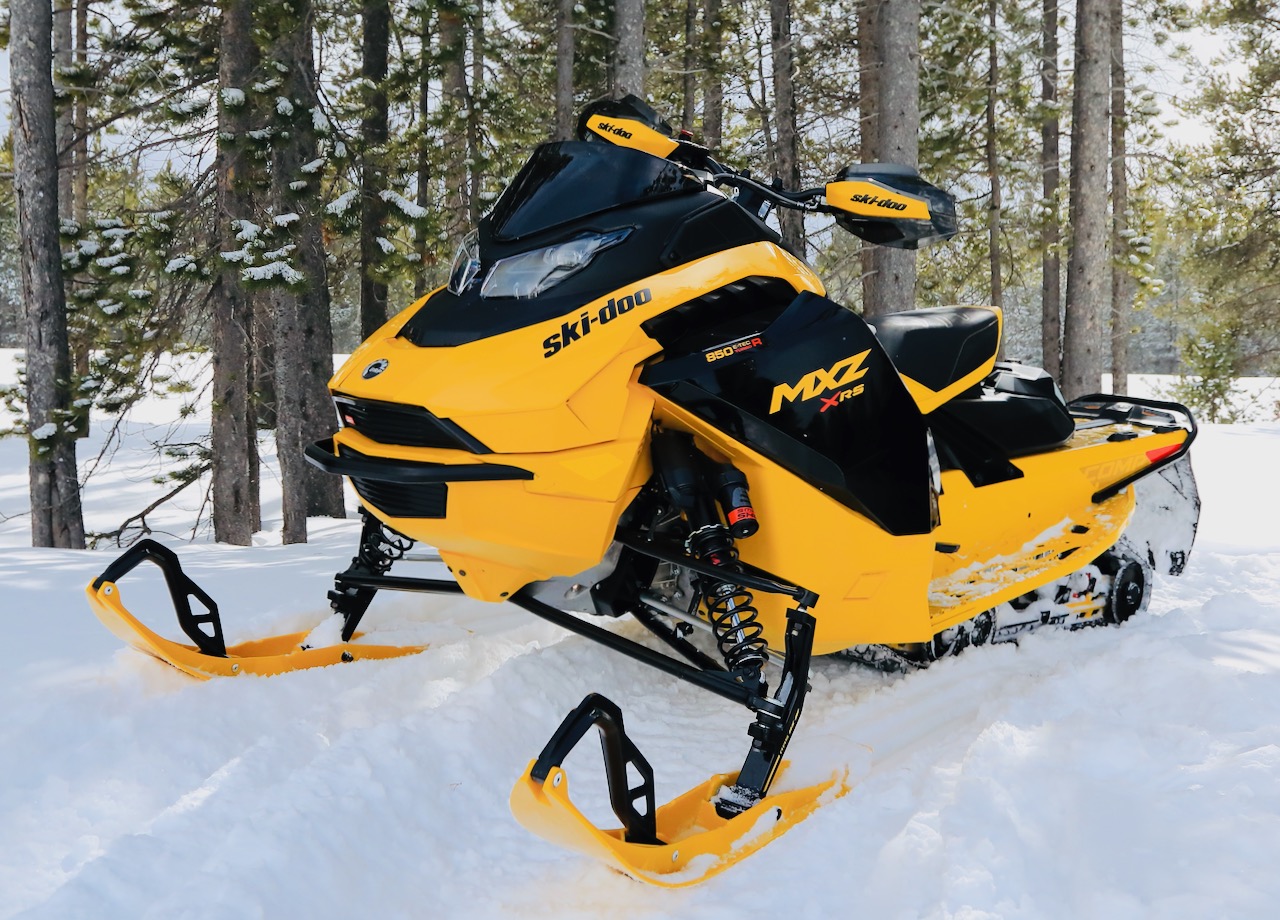
MXZ X-RS 850 E-TEC Turbo R with Smart-Shox. Photo courtesy Motoneige Québec/sledmagazine.com
MXZ X-RS 600R E-TEC with Competition Package
Sli-Doo’s standard-bearer in cross-country racing undergoes some major changes to its shock absorbers for 2025. KYB Pro 40 Kashima shock absorbers with an integral-type base valve for adjusting low- and high-speed compression damping are new. R-type front shock absorbers are also adjustable for rebound.
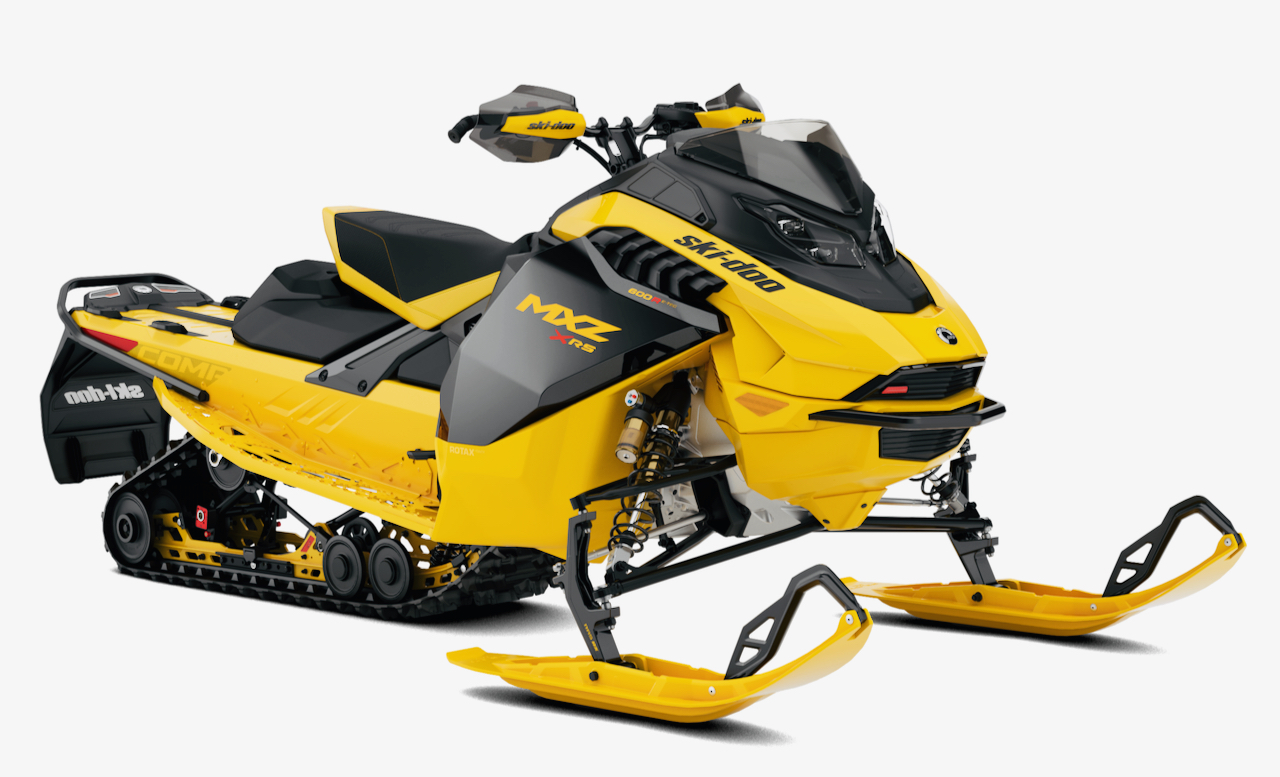
MXZ X-RS 600R E-TEC with Competition Package. Photo courtesy BRP
My Last Word
I spotted the term “roll center” in the RAS RX front suspension section above. Being a tech neophyte, I asked Micky what it means and here’s his roll center 101 answer:
“Any object in motion naturally seeks to travel in a straight line – think of an arrow in flight, for example. Our sleds are no exception to this reality. When the rider of a snowmobile initiates a turn, the snowmobile tries to maintain its straight trajectory. This tendency exerts on the vehicle’s center of gravity, which in turn tries to keep going straight. Therefore, the rider must exert a force on the handlebars to counter this tendency to turn the vehicle.
But the rider’s effort doesn’t cancel the vehicle’s “determination” to continue in a straight line. The result is a combination of understeer and inner ski lift. In short, the snowmobile attempts to continue to go straight, and the rider constantly adjusts to execute the turn.
So, what about the roll center?
This is very important, because it’s the virtual point around which the chassis rolls in a bend. In other words, the point from which the chassis will move, or lean, when negotiating a bend.
On a snowmobile, the roll center is below the centre of gravity. So, as noted above, the geometry of the front suspension determines the roll centre. Finally, it’s important to remember that adjusting these two important elements has a major impact on a snowmobile’s behaviour.
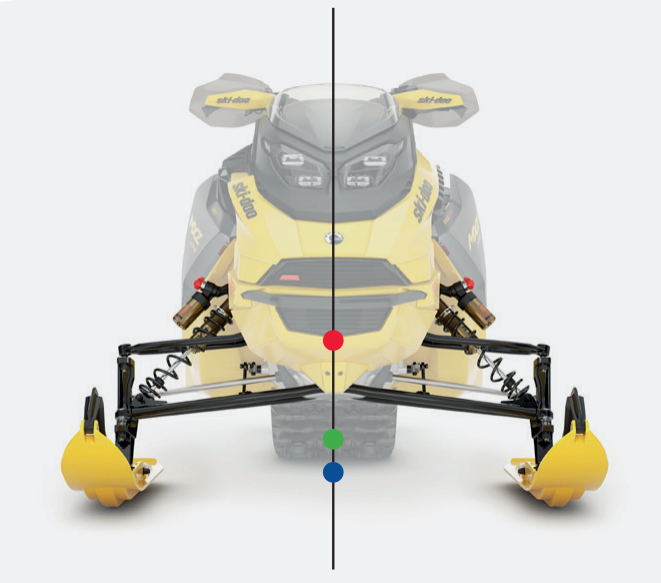
Now imagine a straight line between the centre of gravity (top) and the roll center (see visual above) Then visualize the center of gravity as being the end of a socket spanner on which you are exerting force. In addition, think of the roll center as the socket, the one attached to the bolt you want to tighten or loosen. Anyone who has ever tried to loosen a stuck bolt knows that a longer spanner exerts more force. This “principle” is also true of the “lever” created between the center of gravity and the roll center.
So, raising the roll center (as BRP engineers did when designing the RAS RX front suspension) reduces the impact on the snowmobile’s roll center. Why? Because the lever is shorter, which ultimately reduces disturbance and makes the snowmobile more stable.”
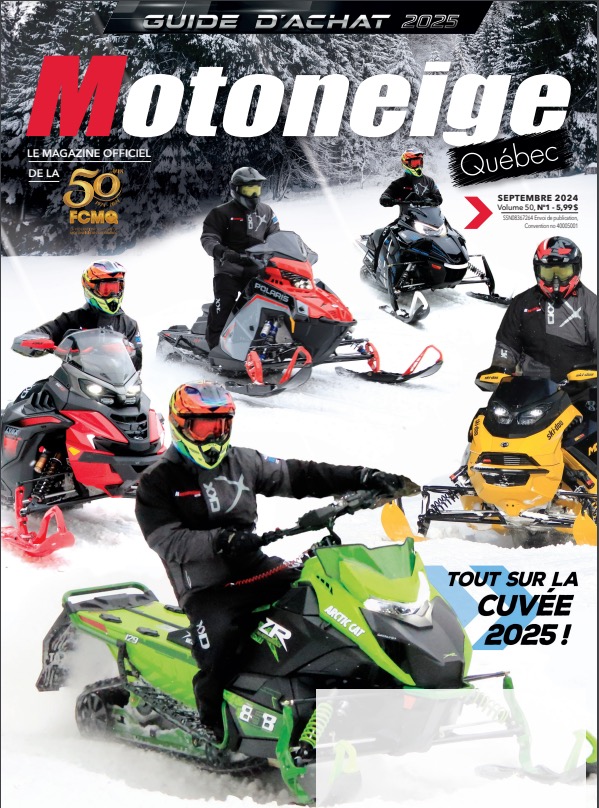
As you can see, whatever brand of snowmobile you ride, tech guru Michel Garneau has you covered. And remember, his What’s New for 2025 posts, first published in Motoneige Quebec Magazine, are now available here for the first time in English! I also remind you once again that this is primarily a trail-riding website. So, we haven’t covered mountain sleds from any OEM. Stay tuned for more tech posts from Micky!
Like This Post? Follow Me on Facebook!
Check out more product reviews.
The tips and advice in this blog are the opinions of the author, may not work in every situation and are intended only for the convenience and interest of the reader, who has the personal responsibility to confirm the validity, accuracy and relevancy of this information prior to putting it to their own use.
